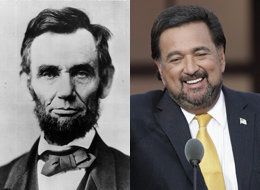
This past week, there was much ado about facial hair between declaring 2008 the year of the mustache, Bill Richardson's missing beard and Obama's admission in 2006 that he can't grow facial hair at all.
A 2001 Slate article analyzing Al Gore's beard, entitled Beards: Why are they such a turnoff?, states:
Not surprisingly, democratically elected politicians have tended to follow fashion trends. The first U.S. president to sport a beard, Abe Lincoln, did so only after his election in 1860, and even then it did not rise above the lower lip... Moustaches--a compromise between primeval assertiveness and civilized cooperation--became popular in the mid-20th century (think Thomas Dewey and Dean Acheson) and unruly beards became popular in the '60s and '70s but only among the counterculture...
An article in The Hill, entitled Capital Living - Voters Want Their Pols Clean Shaven also contemplates beards in Washington:
Men in Congress have varying opinions on facial hair. Some claim they would feel naked without it, that it's part of who they are.
But political consultants, image consultants and etiquette experts say research shows that politicians who wear mustaches and beards don't poll well. Voters don't trust a candidate with facial hair. Think Adolf Hitler, Joseph Stalin, Saddam Hussein and Genghis Khan.
On the other hand, not all hairy types are unappealing; think Abraham Lincoln, Tom Selleck, Burt Reynolds, the late Captain Kangaroo and Santa Claus.
Despite poll data and strong advice suggesting voters favor cleanshaven pols, at least 41 members of the House have whiskers of some sort.
Here are some men who have (mostly) worn it well in years past:
Read an interview with Wolf Blitzer in which he talks all about his beard.